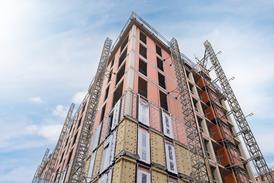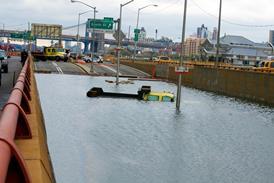Hold on to your hats: although tender prices are still on the up and output is entering a sixth consecutive year of growth, the outlook is gloomy, especially in the commercial new-build, retail and leisure sectors.
Tender prices in the third quarter of this year showed a further rise as a high level of construction activity was maintained. The provisional index for the third quarter stands at 386, an increase of 0.8% over the second-quarter index which has itself been firmed up at 383, slightly higher than the provisional index reported in the August tender price forecast. Examination of further tenders received in the first quarter has also resulted in a revised tender price index of 375.
The provisional index of 386 was at the top of our forecast range and represents an increase of 6.6% over the past year. But it shows a slowdown in the rate of increase to 2.9% over the past six months, which is well down on the trends seen over the last three-and-a-half years. Further softening of prices will occur over the next six months. Even before 11 September the downturn had started to emerge and now talk is of full-blown recession in America with inevitable knock-on effects in the UK.
<B>Output and orders</b>
UK construction output figures for the first six months of 2001 were on course to record the sixth consecutive yearly increase, running 2.2% higher than last year. This is in line with the forecast for total construction output made by Construction Forecasting and Research in June.
New work (excluding repair and maintenance) has also continued to rise. The volume of new work is up 17% between 1995 and 2000 compared with 10% for total workload. In the first six months of this year the volume of new work output was running at a level 0.6% higher than last year, but it is significantly lower than CFR’s forecast for 2001 (1.4%) and is close to the forecast made in June by the Construction Products Association (0.3%).
New orders obtained by contractors in the first quarter of 2001 were worth £8.02bn at constant prices, the highest quarterly figure since the third quarter 1998, which was boosted by some significant infrastructure contract awards. In the second quarter, the value of orders fell to £6.99bn, with, conversely, an unusually low volume of infrastructure new orders. Despite the second-quarter figures, the volume of new orders in the first half of 2001 was running at a level 2.4% higher than in 2000 but only 0.8% higher excluding infrastructure. After the collapse of Railtrack, there seems to be little prospect of a quick recovery in infrastructure spending.
Confirmation of the worsening situation can be seen from the provisional figures for July which, if they are included, show that the volume of new orders, excluding infrastructure, for the first seven months of this year dip below last year’s level. Given the economic shock of 11 September, new orders statistics for the last quarter will almost certainly show a continuation of the downward trend.
<B>Surveys</b>
The Construction Confederation’s Construction Trends Survey for the second quarter of 2001 found that, although growth had slowed compared with the first quarter, work in hand was above normal and contractors remained optimistic about output and enquiries for the year ahead. Two-thirds of building firms surveyed were operating at full or near-full capacity. Serious shortages of bricklayers, plasterers, carpenters and joiners continued to be reported. In East Anglia and parts of the South-east, the shortage of bricklayers has been overtaken by a desperate lack of plasterers and dryliners, even with the attempt to fill the gap with imported Eastern European labour. The survey reported a small increase in margins, rising costs and higher tender prices, in confirmation of the increase identified in this column last quarter.
The Chartered Institute of Purchasing & Supply’s Construction Purchasing Managers’ Index for September signalled expansion of business activity for the 32nd consecutive month with order books rising for the 35th month running. A RICS report published at the beginning of the month also identified workloads rising for the 22nd quarter in a row.
Nevertheless, both of the above reports warn of slowing growth rates. The CIPS survey found that the growth pace of order books eased for the third month running. Optimism fell to the lowest level since December 1998.
In the RICS survey, 26% more chartered surveyors expected a rise in construction workload next quarter rather than a fall, but only 2% thought this would continue into next year.
<B>Repair and maintenance</b>
Overall construction growth this year and next has been forecast to be heavily reliant on the repair and maintenance sector. In June, CFR forecast growth of 3.6% this year and 4.8% next, pumping nearly £4bn extra into this sector of the industry. Public housing R&M should account for a significant proportion of this increase. However, figures from the first half of 2001 continue to disappoint, with expenditure on site running 3% lower than last year.
<B>Commercial activity</b>
There is cause for concern in the private commercial sector. A downturn in this sector has been forecast for some time and it has been hoped that the public sector and repair and maintenance would fill the gap left by a decline in private activity. Last year, this sector accounted for 33% of the new-build market – or £12.6bn of work. Contractors’ new orders were estimated to be worth £9.7bn, with only £1bn attributed to schools, universities and health. Orders for new offices amounted to £4.38bn last year and even some speculative building was begun. But the low point in availability was reached in September last year; since then the amount of available space in central London has slowly increased. This has been partially attributed to the decline in the technology sector. One recent report suggested that over 30,000 City jobs have been axed this year, with investment banks cutting staff by more than 10,000.
Outside central London, the third phase of development at Stockley Park near Heathrow has been halted because of the collapse of the telecoms and technology markets, removing a pool of potential tenants; Sun Microsystems stopped construction of its new headquarters in Fleet, Hampshire in the spring; and Marconi’s £200m headquarters near Coventry, originally due for completion next summer, has now been shelved “for at least a year” because of the company’s financial problems. All of these cutbacks in activity occurred before 11 September, and since then global confidence has nosedived.
In the medium term, the proposed towers for central London are likely to be reconsidered, not because of a change of heart on the part of planners, but because investors will want to be confident that tenants will want to work in them. Speculative work at Canary Wharf in London Docklands has been halted.
Investment in commercial property last year reached record levels, two-thirds higher than in 1999. Investment from overseas more than doubled and accounted for more than 25% of all commercial property investment transactions exceeding £1m, according to consultant DTZ Holdings. US investors dominated this area, but they have been cutting back since last year and, since 11 September, have withdrawn into their shells. New orders for offices look set to slump over the next few months.
<B>Retail</b>
New construction orders in the retail sector peaked in 1998 when the main supermarket chains dominated the top client lists. Last year, orders were worth 19% less in real terms, but £1.89bn worth of work was still to be won by contractors, more than double the amount spent on public sector housing. New orders in the first seven months of 2001 were worth virtually the same as last year, taking inflation into account, and activity may have held up better than some pundits had predicted. Retail sales figures remained strong during the summer, 8% higher than last year, enabling retailers to continue with development plans. However, in America retail expansion plans are on hold since the terrorist attacks. WH Smith, for instance, has admitted that its US airport stores and hotel gift shop expansion programme now remains uncertain. BAA is reviewing its capital expenditure programme, and stores in London’s West End plus other retail centres that rely heavily on tourism will suffer from sharply depressed takings.
<B>Leisure</b>
At the peak of lottery-funded construction projects in 1998-99, expenditure in the entertainment sector exceeded that in retail. New construction projects in this area fell sharply last year, down 18% from the 1999 value and 22% below the level of expenditure seen in 1998. This year, the value is running at its lowest level for six years – only £700m of new construction orders were placed in the first six months of this year compared with over £1.1bn during the same period of 1998 (excluding the effects of inflation over the intervening period).
The main construction output forecasting bodies have marked down their forecasts of activity in this sector, continuing a downward trend already visible last year. Since then, tourism has been hit further by the effects of foot and mouth and now the very substantial reduction in incoming tourists will increase the pain. At the beginning of the year, the upper end of the restaurant market, such as Chez Gerard and Fish!, was talking about ambitious expansion plans. At the end of September, Chez Gerard curtailed its expansion plans, now no longer intending to open any more outlets outside London. The dramatic effect on tourism, particularly in London, is illustrated by the sudden closure of West End shows such as Peggy Sue Got Married after a run of just five weeks. De Vere Hotels has announced a freeze on spending and Hilton Group is reviewing its development plans. Some airport-related hotel developments have already been shelved and tour operators are also curtailing their call centre investments.
Earlier in the year, commentators were talking of a construction bonanza as Britain’s gambling laws are relaxed and casinos were planned up and down the country. Although the change in law is not yet in place, with tourism drastically curtailed, developers’ plans no longer look so attractive. The recent cancellation of the Picketts Lock athletics stadium, intended to host the 2005 World Athletics Championships, is another significant blow to this sector.
<B>Forecast</b>
With the decline in private commercial work likely to be greater than previously envisaged, even greater reliance will be placed by the industry on government-sponsored work in the health, education, transport and public-sector housing fields. However, given the worsening economic conditions reducing tax revenues and the new demands on the government’s appropriately named “war chest”, chancellor Gordon Brown’s promise that the planned investment in public services will be unaffected sounds rather like that of a football club chairman giving a vote of confidence to a struggling manager.
Despite recent interest rate cuts, a further decline in both consumer and business confidence seems inevitable. Job cuts mean the private sector housing market is likely to stagnate further rather than expand in response to cheaper mortgages. Contractors without full order books are likely to sharpen their tenders over the coming weeks in an attempt to gain as much work as possible ahead of a fall off in enquiries. In fact, there is already evidence of some subcontract prices starting to come down. Tender prices may rise only minimally over the year ahead: our prediction is for a rise of between 0% and 3% over the next 12 months. There may be some recovery in confidence after a year and more progress in advancing PFI and public sector work. This could generate price rises of 3-5% in the 12 months to the third quarter of 2003.
The ups and downs at a glance
Current trendsup Tender prices up 0.8% for the third quarter
down Volume of new orders may dip below last year’s level for the first seven months of 2001
down Spending in leisure sector at its lowest for six years
up Two-thirds of building firms operating at full or near-full capacity
up Small increase in margins, says Construction Confederation Forecasts
down Volume of new orders will continue to decline
down Only 2% of RICS members predict workload rises next year
down New orders for offices set to slump
up Tender prices may rise between 0% and 3% over the next 12 months
up Retail centres that rely on tourism are likely to suffer from depressed takings
How the indices are calculated
Mechanical cost indexThe MCI is based on labour rates agreed by the mechanical industry’s wage body, the JCCHVDEI, and materials prices from the Office for National Statistics. Electrical cost index
The ECI is compiled from materials data from the Office for National Statistics and labour costs agreed by the electrical industry’s wage body, the JIBECI. Building cost index
The BCI measures movement in contractors’ labour and materials costs. It is compiled from nationally agreed labour rates and materials prices from the ONS. Tender price index
DL&E’s index is compiled by analysis of successful tenders worth more than £250,000. It includes movement in wage rates, discounts, plant costs, overheads and profits.























